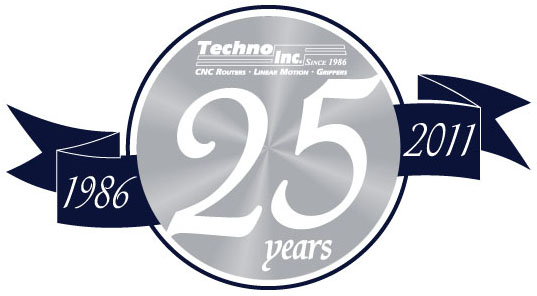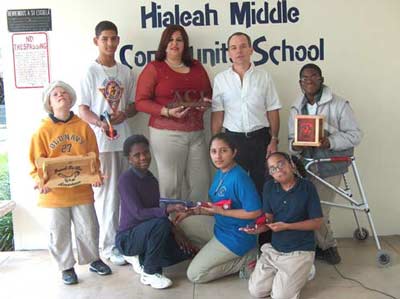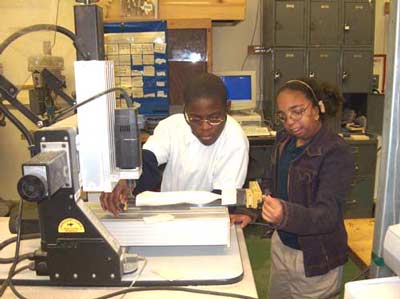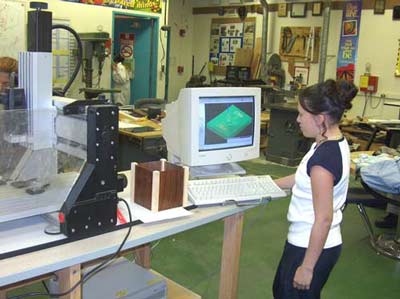


CNC Router
Educational Success Stories
 Affordable Precision Educational CNC Router Affordable Precision Educational CNC RoutereMail us at technosales@technocnc.com |
|
CNC Technology Brings Out Hidden Talents in Physically Disabled
Children By Jeff Lintz
The special education classes at Hialeah Middle School in Miami-Dade County, Florida, include students who are mentally handicapped, deaf, autistic, blind, and physically impaired. In the past, I was often frustrated in working with the physically impaired students because many of them are cognitively normal or above normal yet their physical conditions prevent them from achieving anything close to their true potential in the technology lab. For many students, poor muscle control makes it unsafe for them to use conventional power tools and even if they were able to use them the chances are they would be disappointed because the results would be far below the quality of the designs they are able to conceive. I have seen a number of these students become frustrated over their inability to consummate their designs and give up on what in my opinion might have otherwise been a very fruitful career. One student in particular with muscular dystrophy sticks in my mind. He breezed through his assignments and his creativity was immense but even though I built him a lift to hold him up to use the scroll saw he was never able to complete his projects on his own and the disappointment I saw in him was appreciable. I only wish I had him back now. Bringing technology into the classroom
Along with the DaVinci machine, we got the IMS CO2 system, which allows students to quickly, easily, and inexpensively design and produce finely machined CO2 metric 500 racing cars that meet the specifications for Technology Student Association (TSA) competition. The kit includes specially fitted hardware, interface software, instructional videos and fabrication templates that simplify the design and manufacture of CO2 cars on the Techno DaVinci. The kit makes it possible for any student to produce better cars in much less time, with none of the frustrating and tedious hand carving. But for our physically disabled students the difference is like night and day. Instead of having to rely on others to produce their designs, they can compete on an equal basis with any other student by using the CNC machine to substitute for the fine motor control that many of them lack. How one student benefited I was able to put the new machine to the test almost as soon as it was set up. Two years ago, I had a student with cerebral palsy whose involuntary spastic motions made it unsafe for him to use conventional power tools. But it was clear from the very beginning that he had a very sharp mind and a graphical inclination. When he came into class he was even unable to use a conventional computer mouse so I got him a tracking ball that was much easier for him to manipulate. Almost immediately he demonstrated his ability to create interesting designs on the computer. He took a strong interest in the CO2 racer project and created the model of a car with computer aided design software that had the other kids oohing and aahing. In the past, his enthusiasm probably would have been lessened by me assisting him with hand over hand tooling of the project. But the DaVinci machine gave him a chance to follow the creative process to its logical conclusion. He used the software provided with the DaVinci to cut his design out of a block of wood. The pride on his face when it was finished was truly something to behold. This was perhaps one of the first times in his life when he was able to build something by himself and his self-confidence visibly increased after the project was completed. As the other students in the class begin treating him like an equal and paid much less attention to his physical disabilities, he began to shine. He took a much more active role, such as participating as an integral member of the team that won the Environmental Challenge contest sponsored by the Florida Technology Student Association. The project was a drip irrigation system to conserve water in the butterfly garden and the student I am referring to, designed the display and folder that accompanied the project, as well as doing much of the research. After winning the state contest, the students traveled to the nationals and placed ninth out of the nearly 50 teams entered. I still maintain contact with this student and he is now enrolled at Miami Lakes Educational Center and Miami-Dade College. He has also participated in a statewide leadership youth program for physically impaired and has been called back as a leader for the coming year. How the entire class benefits |
 Techno is celebrating over 25 years of CNC technology
expertise. Our Educational sector provides industrial quality products
at educational prices with a network of award-winning Educators. We can
provide CNC Curriculums, CNC Projects, Technical Information and
Packages for any educational classroom.
Techno is celebrating over 25 years of CNC technology
expertise. Our Educational sector provides industrial quality products
at educational prices with a network of award-winning Educators. We can
provide CNC Curriculums, CNC Projects, Technical Information and
Packages for any educational classroom. In
my career teaching production technology to middle school special
education students, I have had the opportunity to teach many students that
clearly had talent in graphics and design that was never realized because
of their physical disabilities. I have seen, for example, students with an
enormous amount of creativity get frustrated and withdraw because they
weren’t able to build what their mind could conceive with conventional
power tools. In the last several years,
In
my career teaching production technology to middle school special
education students, I have had the opportunity to teach many students that
clearly had talent in graphics and design that was never realized because
of their physical disabilities. I have seen, for example, students with an
enormous amount of creativity get frustrated and withdraw because they
weren’t able to build what their mind could conceive with conventional
power tools. In the last several years,  About
three years ago, far-sighted local school officials made the decision to
purchase and bring CNC machinery into the classroom.
About
three years ago, far-sighted local school officials made the decision to
purchase and bring CNC machinery into the classroom.  It’s
important to note that the value of CNC technology extends far beyond
physically disabled students. For example, all of my students participated in
a project earlier this year to build nameplates for a meeting of principals
from throughout the school district that was held at my school.
It’s
important to note that the value of CNC technology extends far beyond
physically disabled students. For example, all of my students participated in
a project earlier this year to build nameplates for a meeting of principals
from throughout the school district that was held at my school.